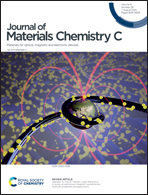Hypercoordinate two-dimensional transition-metal borides for spintronics and catalyst applications†
Abstract
Two-dimensional (2D) magnetic materials have shown promise as ideal platforms for constructing novel spintronic devices. To date, most 2D magnetic materials have mainly been obtained by the exfoliation of magnetic bulks, which greatly limits their high-quality mass production. In this work, we predicted a hypercoordinate 2D planar structure made from transition-metal borides MB9 (M = Mn, Cr, V, Ti; B = boron), whose magnetic properties could be tuned by changing the type of the transition metal through a set of structural searches combined with first-principles calculations. The synthesis of MB9 could be achieved through chemical vapor deposition by combining transition-metal M atoms with the novel 2D planar boron sheet B9 on a Ag (111) substrate. The structural stabilities of MB9 structures were proved using a set of phonon dispersion, molecular dynamics, and elastic constant calculations. Most interestingly, MnB9 showed excellent magnetic properties because of its 100% spin polarization ratio at the Fermi level, high Curie temperature of 240 K, and robust perpendicular magnetic anisotropy energy of 180 μeV per Mn atom, which suggest it could be a promising candidate for enabling ferromagnetic spintronics at the nanoscale. In addition, all MB9 structures showed excellent catalytic activity for the hydrogen evolution reaction (HER) compared with HER-inactive B9 because the adsorption of M atom induces charge redistribution in the boron sheet.



 Please wait while we load your content...
Please wait while we load your content...